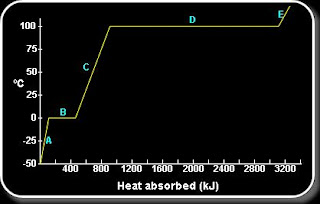Introduction:
We know , kinetic energy per molecule , per degree of freedom is `1/2` kT
Therefore kinetic energy per molecule with three degrees of freedom is `3/2` kT
Total kinetic energy of one mole of the monoatomic gas is given by
E =`3/2` kT* N
= `3/2` RT, where N is Avogadro number
`(dE)/(dT) = 3/2R`
If dE is small amount of heat required to raise the temperature of 1 mole of the gas at constant volume, through a temperature dT
dE = 1 x Cv x dT
Cv = = `(dE)/(dT) = 3/2 R`
As R = 8.32 J mol-1K-1
Cv = `3/2` 8.31
Cv = 12.465 J mol-1 K-1
Cp is molar specific heat at constant pressure.
Then Cp –Cv = R
Cp = CV +R
= `3/2` R +R = `5/2` R = `5/2` x 8.32 = 20.775 J mol-1K-1
E = 5 x `1/2` kT x N = `5/2` RT
Also Cv = `(dE)/(dT)` = `d/(dT) (5/2 RT)`
= `5/2` R
Cv = `5/2` x 8.31 = 20.775 Jmol-1K-1
But Cp = Cv +R
= `5/2` R +R
= `7/2` R
= `7/2` x 8.31 = 29.0.85 J mol-1K-1
Molar
specific heat capacity of a gas at constant volume Cv is defined as the
quantity of heat required to raise the temperature of one mole of a gas
through 1 K keeping its volume constant.
Specific heat Cv of ,monoatomic , diatomic are discussed here.
Specific heat Cv of ,monoatomic , diatomic are discussed here.
Specific Heat Cv of Monoatomic Gases:
Monoatomic gases like argon helium have three degrees of freedom.We know , kinetic energy per molecule , per degree of freedom is `1/2` kT
Therefore kinetic energy per molecule with three degrees of freedom is `3/2` kT
Total kinetic energy of one mole of the monoatomic gas is given by
E =`3/2` kT* N
= `3/2` RT, where N is Avogadro number
`(dE)/(dT) = 3/2R`
If dE is small amount of heat required to raise the temperature of 1 mole of the gas at constant volume, through a temperature dT
dE = 1 x Cv x dT
Cv = = `(dE)/(dT) = 3/2 R`
As R = 8.32 J mol-1K-1
Cv = `3/2` 8.31
Cv = 12.465 J mol-1 K-1
Cp is molar specific heat at constant pressure.
Then Cp –Cv = R
Cp = CV +R
= `3/2` R +R = `5/2` R = `5/2` x 8.32 = 20.775 J mol-1K-1
Specific Heat Cv of Diatomic Gases:
In diatomic gases like hydrogen , oxygen , nitrogen etc, a molecule has five degrees of freedom. Hence the total energy associated with one mole of diatomic gas isE = 5 x `1/2` kT x N = `5/2` RT
Also Cv = `(dE)/(dT)` = `d/(dT) (5/2 RT)`
= `5/2` R
Cv = `5/2` x 8.31 = 20.775 Jmol-1K-1
But Cp = Cv +R
= `5/2` R +R
= `7/2` R
= `7/2` x 8.31 = 29.0.85 J mol-1K-1









